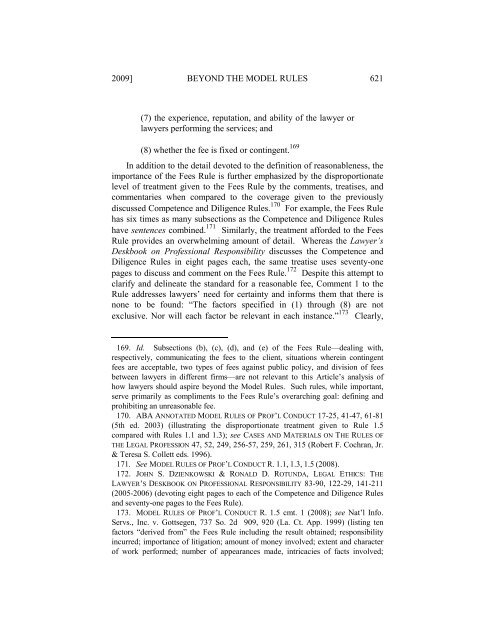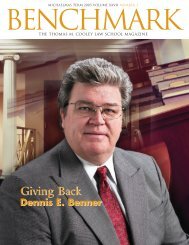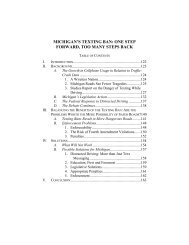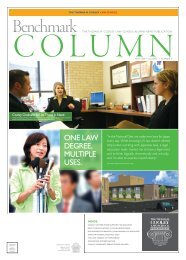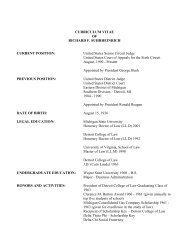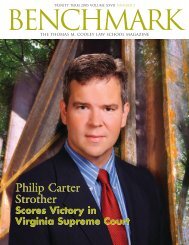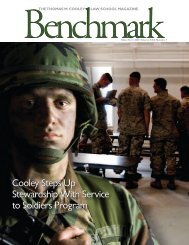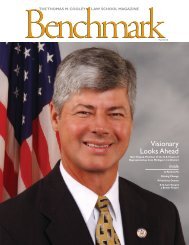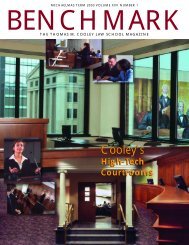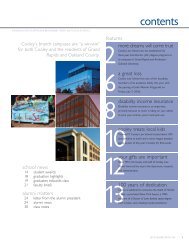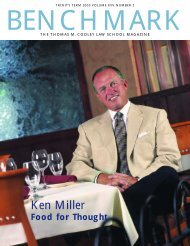Beyond The Model Rules - Thomas M. Cooley Law School
Beyond The Model Rules - Thomas M. Cooley Law School
Beyond The Model Rules - Thomas M. Cooley Law School
You also want an ePaper? Increase the reach of your titles
YUMPU automatically turns print PDFs into web optimized ePapers that Google loves.
2009] BEYOND THE MODEL RULES 621(7) the experience, reputation, and ability of the lawyer orlawyers performing the services; and(8) whether the fee is fixed or contingent. 169In addition to the detail devoted to the definition of reasonableness, theimportance of the Fees Rule is further emphasized by the disproportionatelevel of treatment given to the Fees Rule by the comments, treatises, andcommentaries when compared to the coverage given to the previouslydiscussed Competence and Diligence <strong>Rules</strong>. 170 For example, the Fees Rulehas six times as many subsections as the Competence and Diligence <strong>Rules</strong>have sentences combined. 171 Similarly, the treatment afforded to the FeesRule provides an overwhelming amount of detail. Whereas the <strong>Law</strong>yer’sDeskbook on Professional Responsibility discusses the Competence andDiligence <strong>Rules</strong> in eight pages each, the same treatise uses seventy-onepages to discuss and comment on the Fees Rule. 172 Despite this attempt toclarify and delineate the standard for a reasonable fee, Comment 1 to theRule addresses lawyers’ need for certainty and informs them that there isnone to be found: “<strong>The</strong> factors specified in (1) through (8) are notexclusive. Nor will each factor be relevant in each instance.” 173 Clearly,169. Id. Subsections (b), (c), (d), and (e) of the Fees Rule—dealing with,respectively, communicating the fees to the client, situations wherein contingentfees are acceptable, two types of fees against public policy, and division of feesbetween lawyers in different firms—are not relevant to this Article’s analysis ofhow lawyers should aspire beyond the <strong>Model</strong> <strong>Rules</strong>. Such rules, while important,serve primarily as compliments to the Fees Rule’s overarching goal: defining andprohibiting an unreasonable fee.170. ABA ANNOTATED MODEL RULES OF PROF’L CONDUCT 17-25, 41-47, 61-81(5th ed. 2003) (illustrating the disproportionate treatment given to Rule 1.5compared with <strong>Rules</strong> 1.1 and 1.3); see CASES AND MATERIALS ON THE RULES OFTHE LEGAL PROFESSION 47, 52, 249, 256-57, 259, 261, 315 (Robert F. Cochran, Jr.& Teresa S. Collett eds. 1996).171. See MODEL RULES OF PROF’L CONDUCT R. 1.1, 1.3, 1.5 (2008).172. JOHN S. DZIENKOWSKI & RONALD D. ROTUNDA, LEGAL ETHICS: THELAWYER’S DESKBOOK ON PROFESSIONAL RESPONSIBILITY 83-90, 122-29, 141-211(2005-2006) (devoting eight pages to each of the Competence and Diligence <strong>Rules</strong>and seventy-one pages to the Fees Rule).173. MODEL RULES OF PROF’L CONDUCT R. 1.5 cmt. 1 (2008); see Nat’l Info.Servs., Inc. v. Gottsegen, 737 So. 2d 909, 920 (La. Ct. App. 1999) (listing tenfactors “derived from” the Fees Rule including the result obtained; responsibilityincurred; importance of litigation; amount of money involved; extent and characterof work performed; number of appearances made, intricacies of facts involved;


